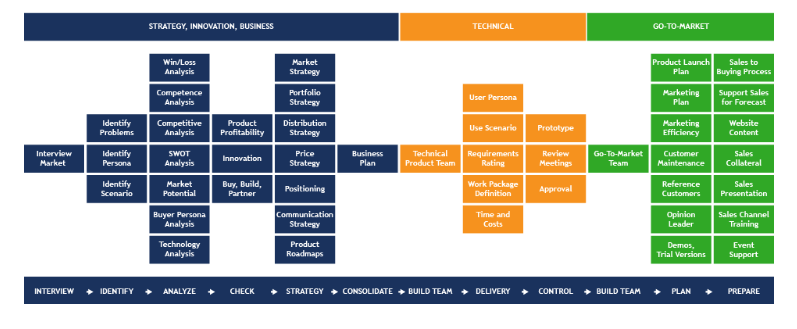The following article Key Performance Indicators is the 1st part of our series "KPIs for Product Managers". It explains which key performance indicators gain relevance at which point in time and where the data can be collected and use practical examples to show "Best practice."
Product managers deal with a number of challenges every day: the next requirement, the most important customer and his requirements, the development is behind schedule, sales and marketing need information, the boss sits on his neck and wants a reason why his product idea is not implemented, ...
Most product managers have not even defined the most essential key performance indicators, i.e.KPIs, for the product. They do not measure them (or not on a regular basis), forget to set up action plans. When thresholds are exceeded, they need too long to react to them.
A multitude of tactical and operational measures regulate the daily routine of many product managers. At the end of a day, product managers and product marketing managers can hardly answer the following question: "What have I done today to make my product more successful?"
Key performance indicators are one of the most powerful leadership tools. They reflect a company's performance in many ways and show correlation between figures from different departments. Coherences and deviations must be analyzed and understood.
In order to convey the strategic approach, its implementation as well as the stumbling blocks in the KPI-analysis, the following topics are considered:
Key Performance Indicators Analysis
- The strategic importance of KPIs for product management
- KPI basics: What to consider when defining KPIs
- Goals, comparison values, categorization
- External key figures and key operating figures
- Data collection, measurement and dashboards
- Financial and corporate key figures - KPI examples and explanations
- Sales key figures – KPI examples and explanations
- Market key figures – KPI examples and explanations
- Marketing key figures – KPI examples and explanations
- Product key figures – KPI examples and explanations
- The strategic importance of KPIs for product management
Product managers lead their products to success. The best amongst them can answer easily the following question
- What is the product profitability of my product?
- How has profitability developed in the last 6 months?
- Which KPIs do show deviations?
According to our practical experience almost 90% of product answer can answer the first questions. This is less valid technical product managers who mainly write specifications and have a "business" colleague in product management. More than half of the 90% PMs can answer subsequent questions only partially or not at all. Only about 25% can answer this relatively accurately or precisely.
Product managers should think like a CEO: If a successful CEO receives an attractive sounding offer from another company, he wants to know the key figures of the company! How is the profitability, sales, margin, compared to the market? How have the key figures developed over the last years, besides other aspects like innovation, brand awareness, area of responsibility, size and maybe salary.
A CEO will not blindly accept a new challenge without knowing roughly what the general conditions are like. It makes a difference to lead a company that has been highly profitable for several years to the next peak than to join a company that has been making losses for years and is on the verge of insolvency.
Good sales managers act similarly, they know their current sales figures very well and know what results to expect.
Why do many product managers know so few KPIs of their product, when they are often regarded as the "CEO of their product?" If a product manager is not familiar with the most important figures of his product – how can others trust his decisions or recommendations?
Being a good leader of a product means that colleagues and employees follow. They will do so as long as they recognize a strategic direction and understand the logic behind the figures and actions.
Product managers, who are professional leaders of their product, know the current status of the most important KPIs, can analyze them and explain how they support the current strategy.
Therefore it is inevitably necessary both to know the company’s strategy and to set up the product strategy and then the key performance indicators. This can be learned in the Course "Strategic Product Management", according to the Open Product Management Workflow™.
Open Product Management Workflow™
- Course: Strategic Product Management
- Course: Technical Product Management
- Course: Successful Go-to-Market

Questions to identify relevant Key Performance Indicators
- What is the overall goal for the product in the next 6, 12, 24 months?
- Should a large user community be built up first, or should the turnover grow from the first day on?
- How much margin or profit should the product generate?
- Do we have to reduce cost to become more profitable
- How is the sales pipeline built up?
- What is the roadmap of the product, in which direction (target markets, problems of new customer groups, functionalities, market share) does the product develop - and why?
- As soon as new functionalities should help to address new markets or customer groups, at what point in time will realistically generate sales with new customers at the earliest ?
These seven questions show that from a multitude of KPIs, the most important ones should be selected to reflect the current strategy while keeping an eye on the medium-term.
A good product manager agrees with the CEO on the KPI that are needed and has them up to date at all times. It is just like a private person ask his bank for a loan and is asked to provide details, such as income, debts and assets to make a decision.
The next articles will point out dependencies and also stumbling blocks that the product manager can better avoid. With the knowledge of KPIs and a fast reaction upon a deviation a product manager can built trust and reputation for his role.
Where should product management start with KPIs?
Today’s product manager are required to know and understand the company's key figures and balance sheets. It is not necessary to understand every single cost element and accounting methodology, but to understand the most important data that is available – internally also externally. It is beneficial to sit down with the financial director or controller to understand a company's key figures and their goals. Every company uses different names and sometimes even calculation for i.e. sales, net profit, margin and margin target, fixed costs, cogs etc.
First of all, there is the "understanding of terminology", next the application of this terminology in discussions and decision papers. A CEO or board understands it well and expects the same language. If the product manager speaks the same language in decision papers or meetings with the management, he will be seen as the "entrepreneur of his product" and will receives a faster buy-in for his ideas.
The Elevator Pitch
With the following example we show the importance of speaking the language of the management.
A CEO or board understands it well and expects the same language. If the product manager speaks the same language in decision papers or meetings with the management, he will be seen as the "entrepreneur of his product" and will receives a faster buy-in for his ideas.
CEO asks: "How is your product?"
The product manager answers: "Great, we are currently planning the new release, ... cool new technology, hot features in the next version, semantic intelligence, SOA based, ... technology & feature bla bla..."
Before the product manager is able to elaborate more the product manager has to leave on the 11th floor. The CEO still has 8 floors to go and think.
What will he most likely think?
Probably the following: "What is he talking about? Does he know what he is doing? I did not understand a word! Is this the right guy for this job? I really need to talk to his manager... It seems to me that the product management has no idea what they are there for and what they do..."
With a prepared "elevator pitch" for a product a ride with the CEO becomes fun and not a pain. The information to deliver shall be "short and sweet" and ready for the relevant company "buying" personas, decision makers, influencers and team members.
In addition to management, there are some more roles that need a short and concise story. Each of them speaks a different language and has a different perspective on the topic, such as sales, head of engineering, project management and head of marketing. The writing of those stories and summary of the relevant KPI is just like a positioning for a buying persona:
- CEO or top management: performance, growth, and strategic impact for the company.
- Sales and/or Marketing Manager: How can these people achieve their goals e.g. sales target and marketing program success with the product and what is the actual performance?
- Development Manager: Needs a good feeling that his team is well involved, that planning, and communication is going well, so that he can deliver the products in the given time and quality. The planning is strategic, and priorities do not change from one day to the next.
- Sales Representative / Account Manager: How can he sell more? How can he better serve and support his customers?
- Developer: How is his work supposed to be recognized by management and customers? What is the current success? What comes next, how do we solve the "time problem"?
As soon as the product manager understands the language and goals of the decision-makers, he selects key performance indicators.
To learn more about key performance indicators go on reading part 2: Defining KPIs



















